Charles E W Bean, Diaries, AWM38 3DRL 606/266/1 - September 1918 - Part 3
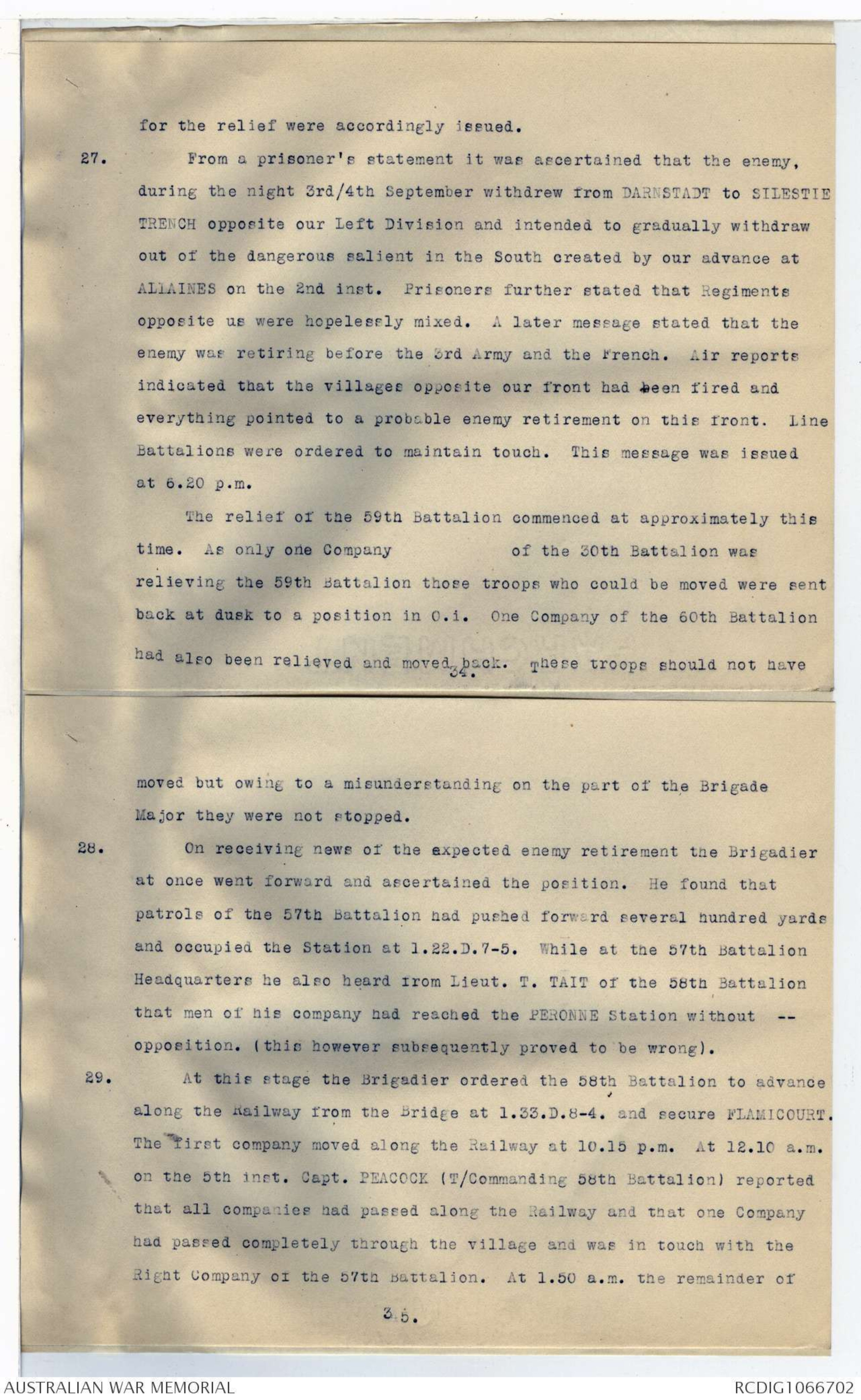
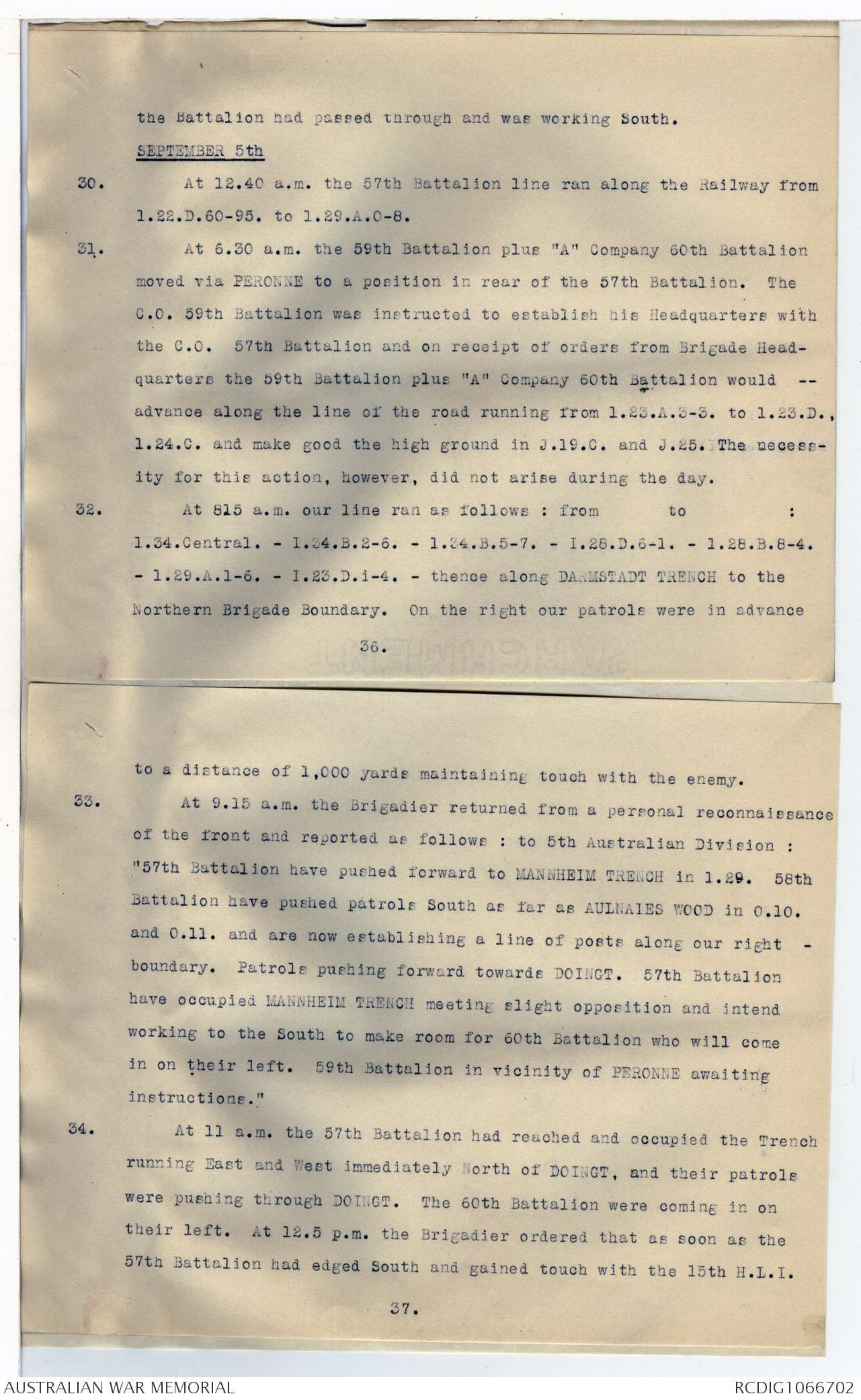
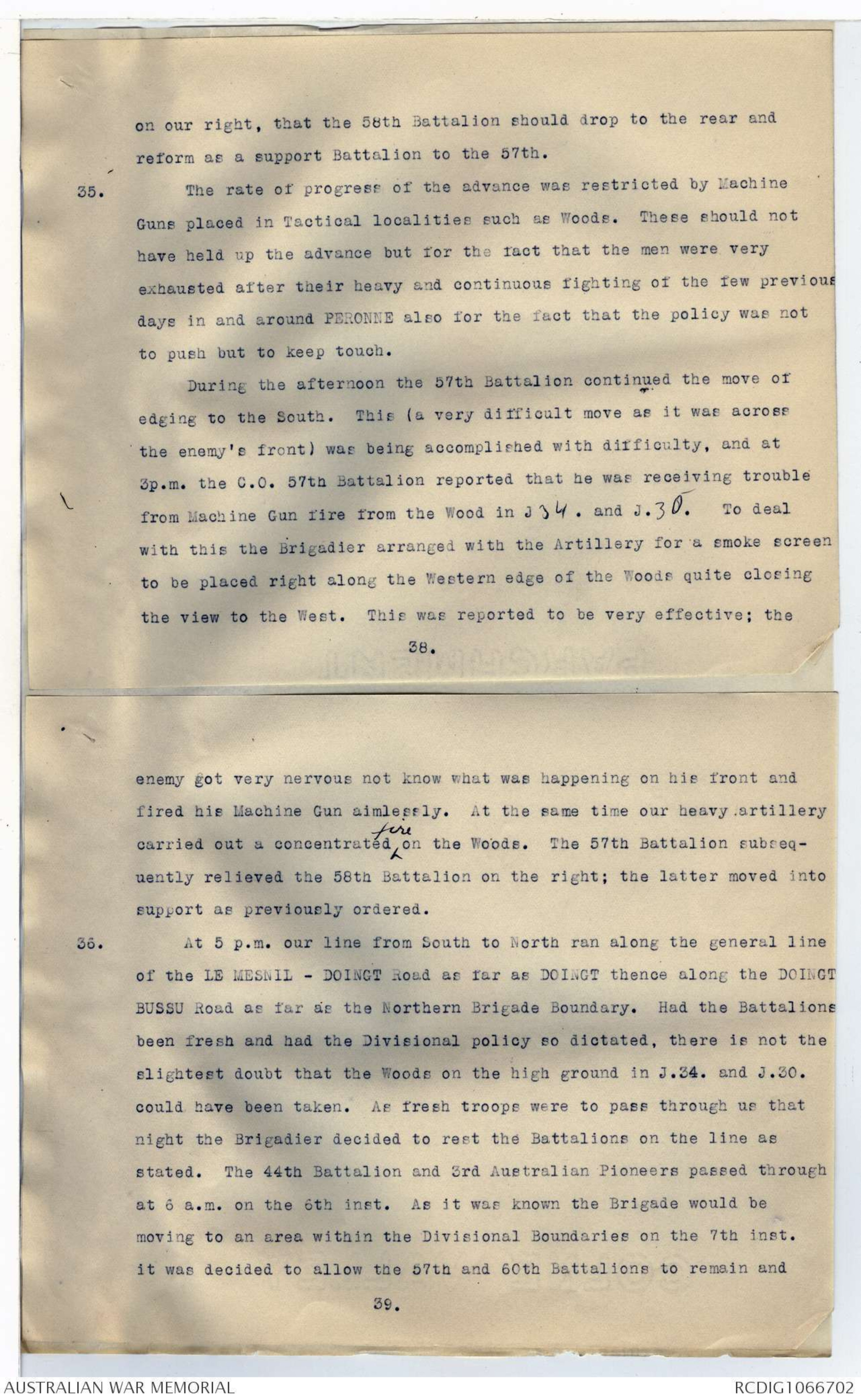
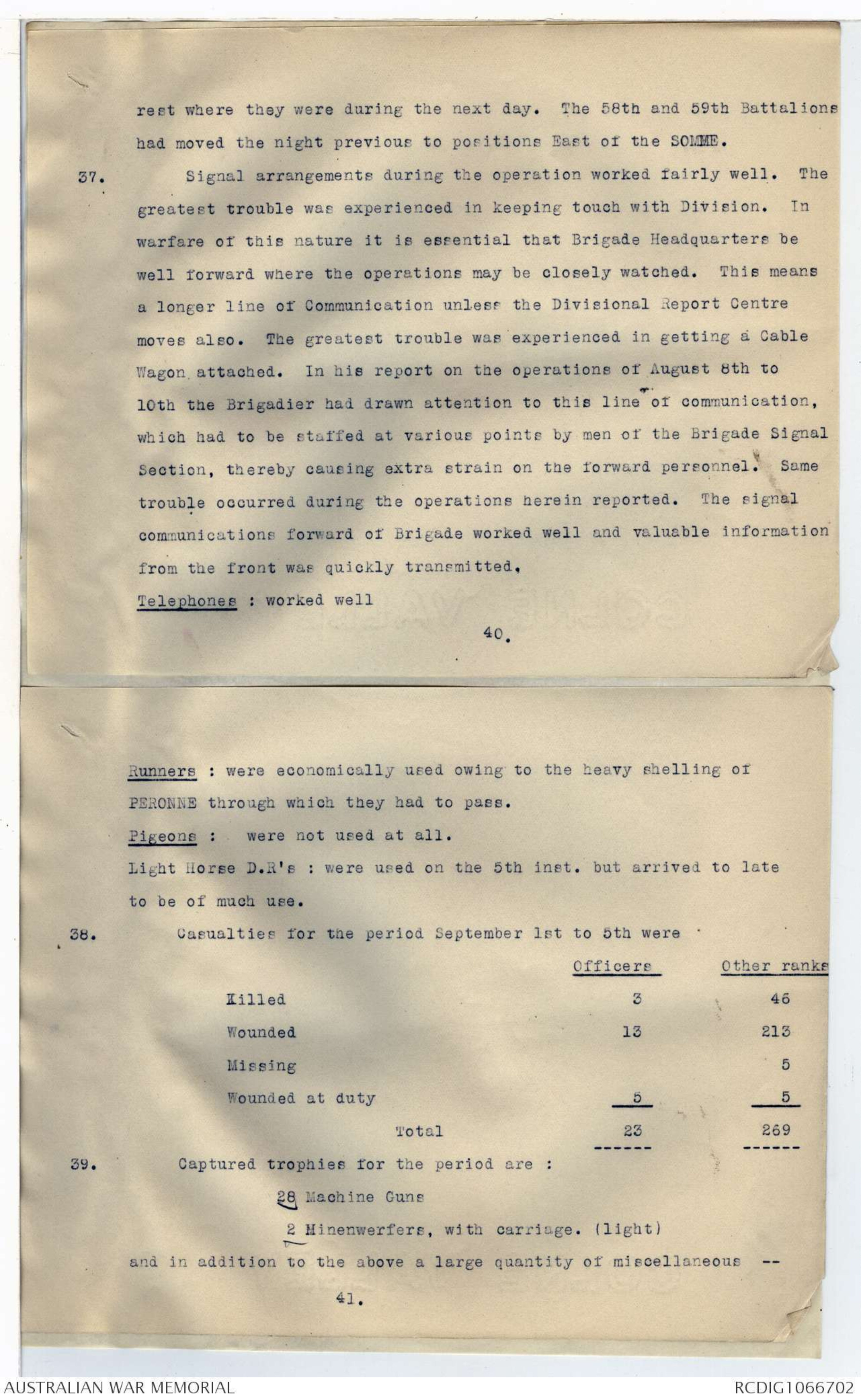
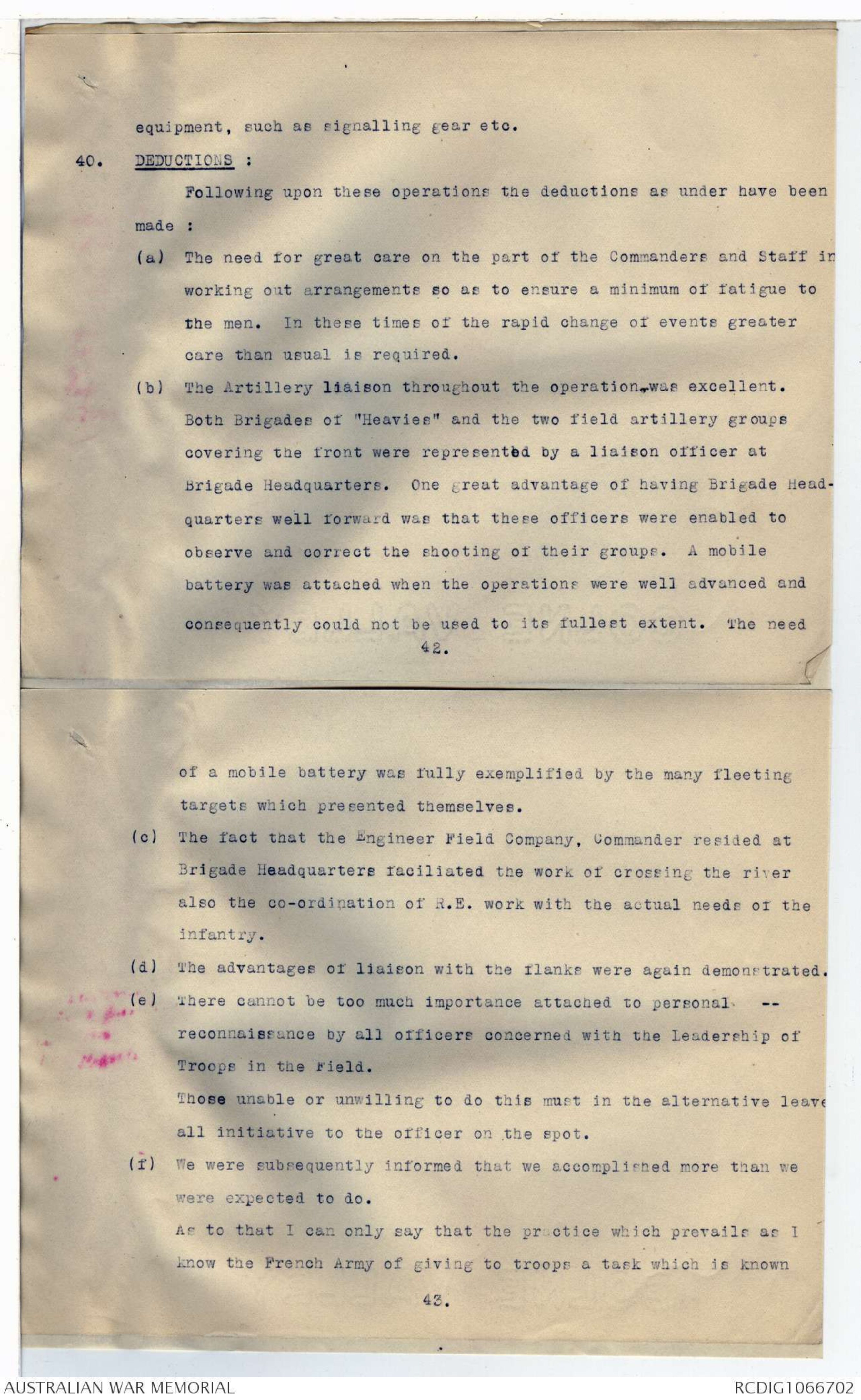
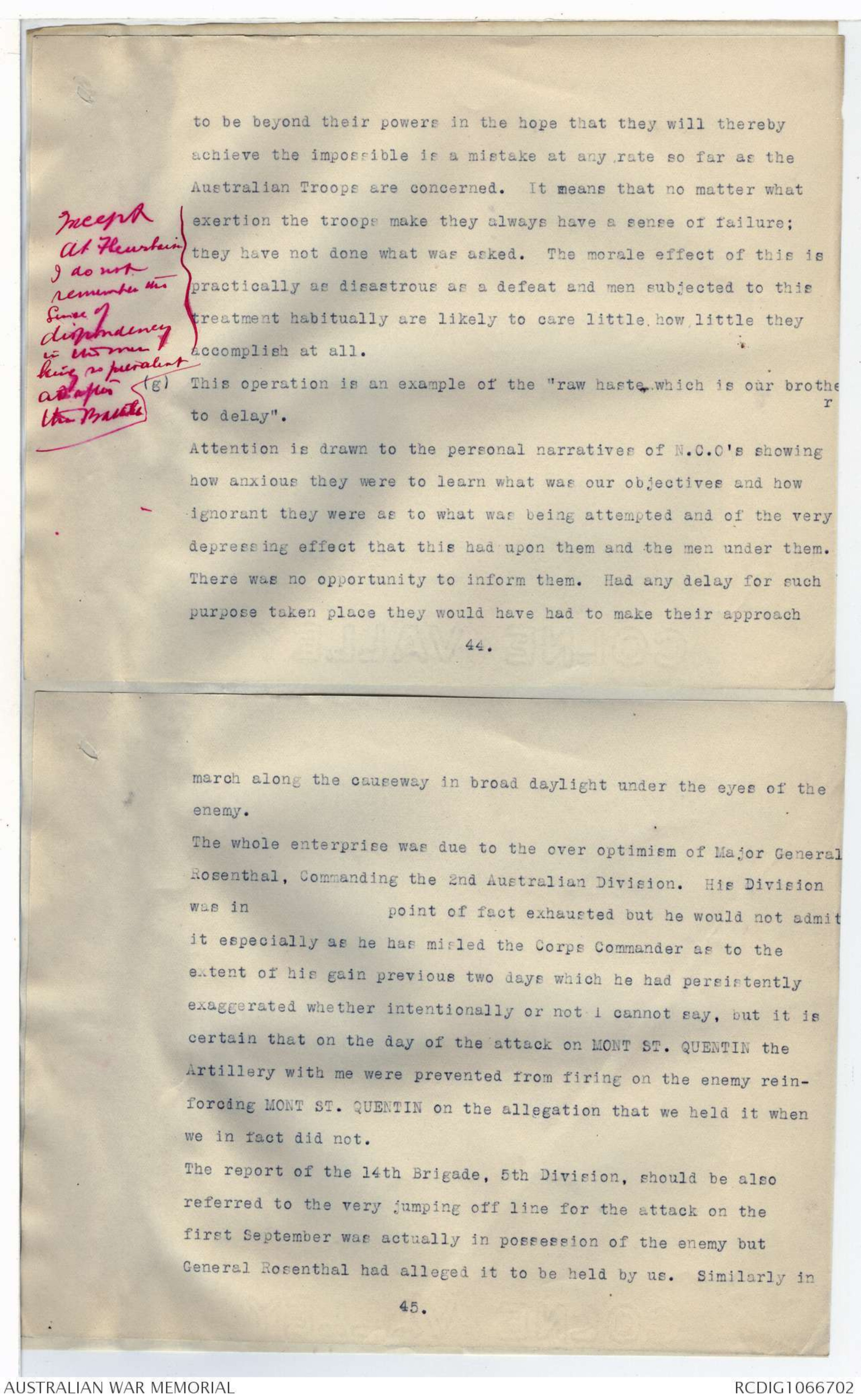
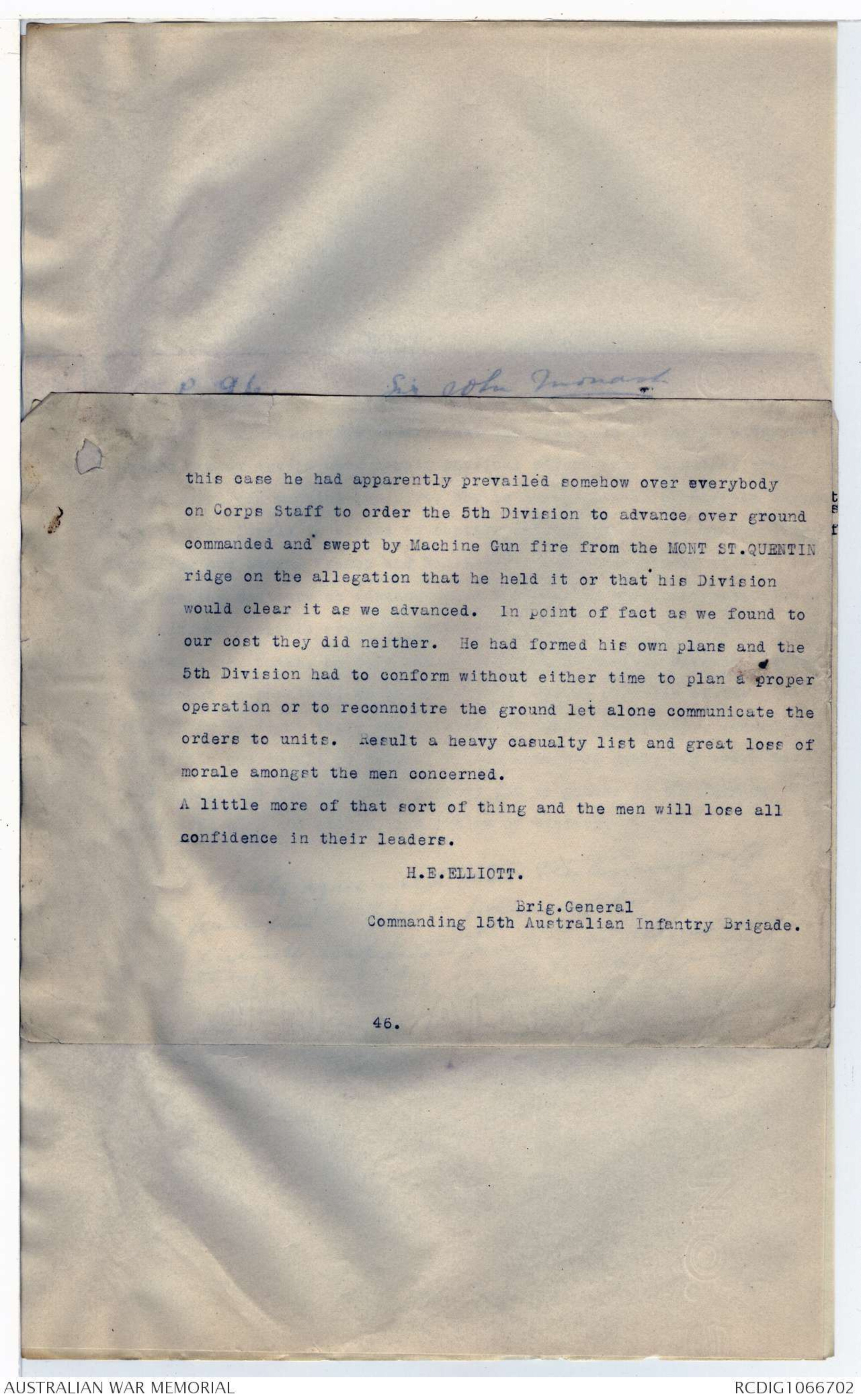
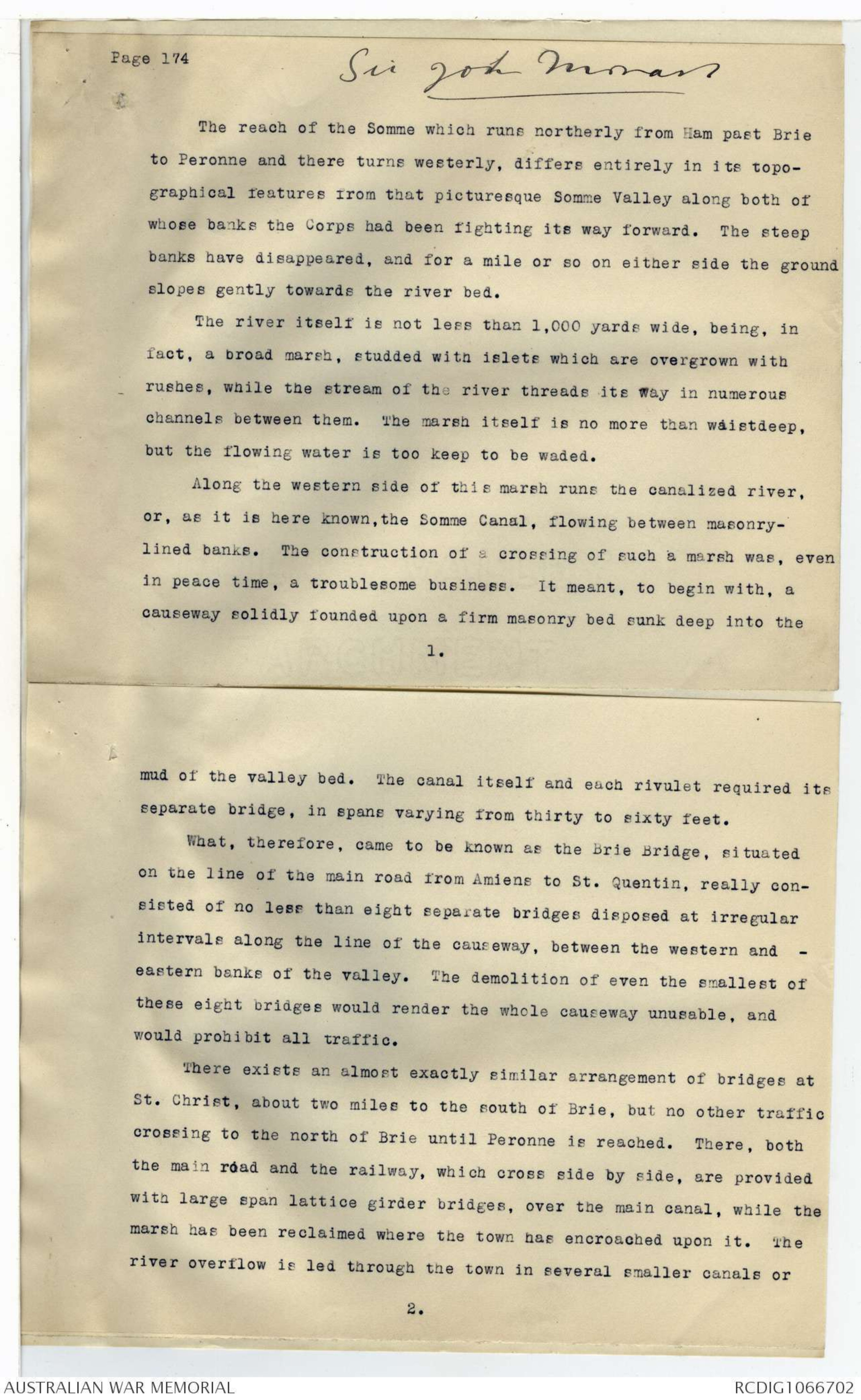
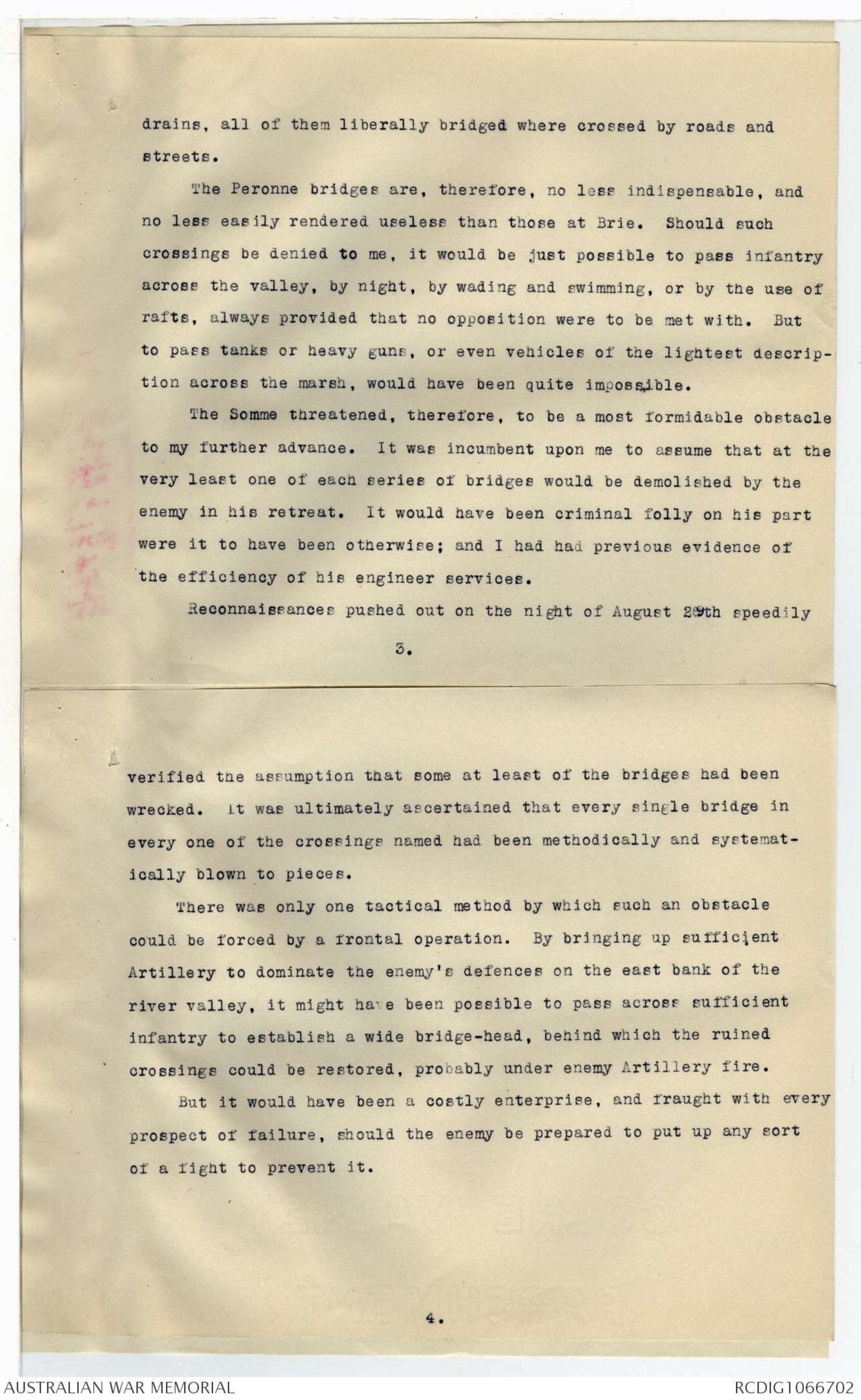
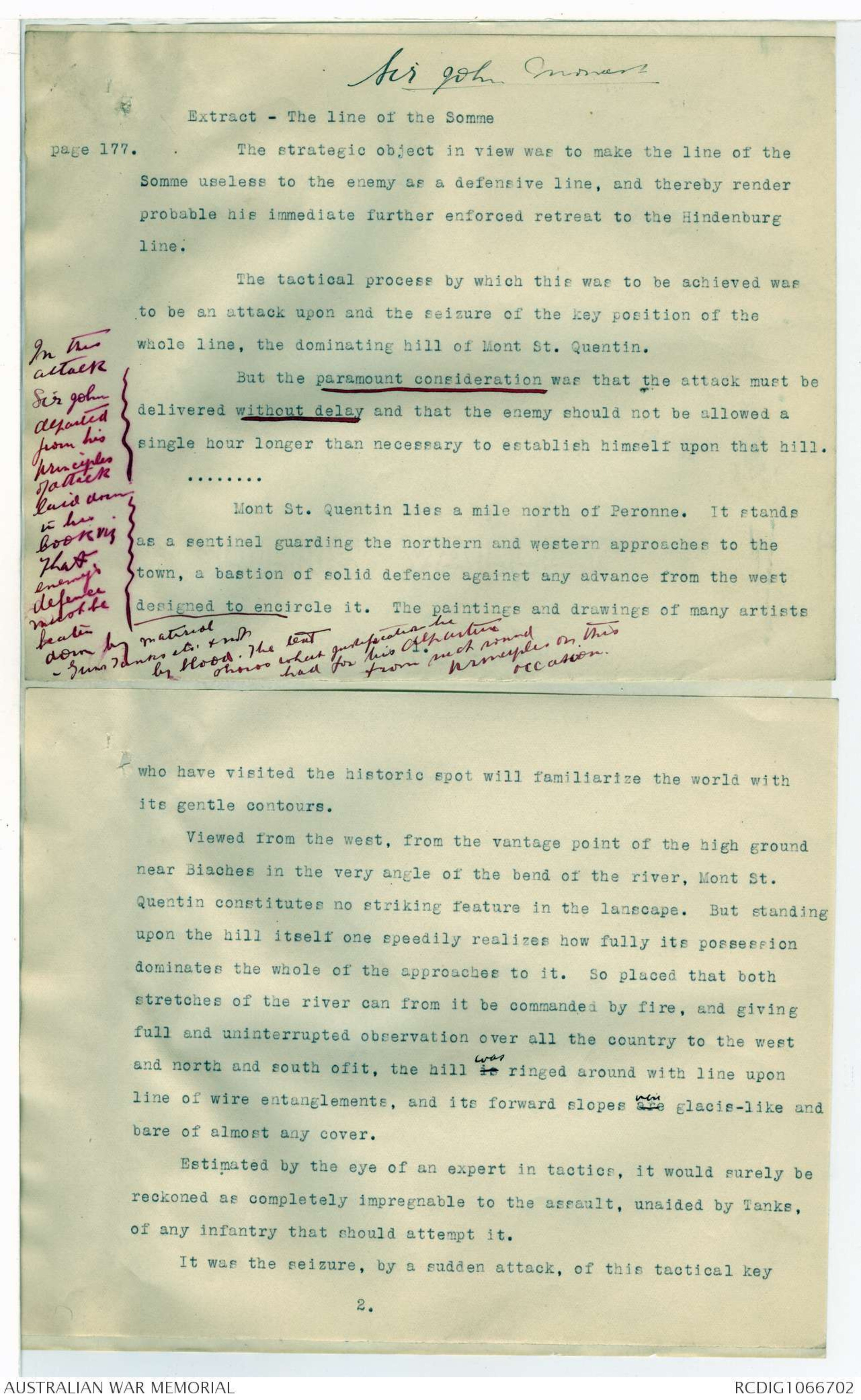
for the relief were accordingly issued.
27. From a prisoner's statement it was ascertained that the enemy,
during the night 3rd/4th September withdrew from DARNSTADT to SILESTIE
TRENCH opposite our Left Division and intended to gradually withdraw
out of the dangerous salient in the South created by our advance at
ALLAINES on the 2nd inst. Prisoners further stated that Regiments
opposite us were hopelessly mixed. A later message stated that the
enemy was retiring before the 3rd Army and the French. Air reports
indicated that the villages opposite our front had been fired and
everything pointed to a probable enemy retirement on this front. Line
Battalions were ordered to maintain touch. This message was issued
at 6.20 p.m.
The relief of the 59th Battalion commenced at approximately this
time. As only one Company of the 30th Battalion was
relieving the 59th Battalion those troops who could be moved were sent
back at dusk to a position in O. i. One Company of the 60th Battalion
had also been relieved and moved back. These troops should not have
34.
moved but owing to a misunderstanding on the part of the Brigade
Major they were not stopped.
28. On receiving news of the expected enemy retirement the Brigadier
at once went forward and ascertained the position. He found that
patrols of the 57th Battalion had pushed forward several hundred yards
and occupied the Station at 1. 22. D. 7-5. While at the 57th Battalion
Headquarters he also heard from Lieut. T. TAIT of the 58th Battalion
that men of his company had reached the PERONNE Station without --
opposition. (this however subsequently proved to be wrong).
29. At this stage the Brigadier ordered the 58th Battalion to advance
along the Railway from the Bridge at 1. 33. D. 8-4. and secure FLAMICOURT.
The first company moved along the Railway at 10.15 p.m. At 12.10 a.m.
on the 5th inst. Capt. PEACOCK (T/Commanding 58th Battalion) reported
that all companies had passed along the Railway and that one Company
had passed completely through the village and was in touch with the
Right Company of the 57th Battalion. At 1.50 a.m. the remainder of
35.
the Battalion had passed through and was working South.
SEPTEMBER 5th
30. At 12.40 a.m. the 57th Battalion line ran along the Railway from
1. 22. D. 60-95. to 1. 29. 4. 0-8.
31. At 6.30 a.m. the 59th Battalion plus "A” Company 60th Battalion
moved via PERONNE to a position in rear of the 57th Battalion. The
C.O. 59th Battalion was instructed to establish his Headquarters with
the C.O. 57th Battalion and on receipt of orders from Brigade Headquarters
the 59th Battalion plus "A” Company 60th Battalion would --
advance along the line of the road running from 1. 23. 4. 3-3. to 1. 23. D. 1. 24. C.
and make good the high ground in J. 19. C. and J. 25. The necessity
for this action, however, did not arise during the day.
32. At 8.15 a.m. our line ran as follows : from to :
1. 34. Central. - I. 34. B. 2-6. - I. 34. B. 5-7. - I. 28. D. 6-1. - 1. 28. B. 8-4.
- 1. 29. 4. 1-6. - I. 23. D. i-4. - thence along DARMSTADT TRENCH to the
Northern Brigade Boundary. On the right our patrols were in advance
36.
to a distance of 1,000 yards maintaining touch with the enemy.
33. At 9.15 a.m. the Brigadier returned from a personal reconnaissance
of the front and reported as follows : to 5th Australian Division:
"57th Battalion have pushed forward to MANNHEIM TRENCH in 1. 29. 58th
Battalion have pushed patrols South as far as AULNAIES WOOD in 0. 10.
and 0. 11. and are now establishing a line of posts along our right -
boundary. Patrols pushing forward towards DOINGT. 57th Battalion
have occupied MANNHEIM TRENCH meeting slight opposition and intend
working to the South to make room for 60th Battalion who will come
in on their left. 59th Battalion in vicinity of PERONNE awaiting
instructions."
34. At 11 a.m. the 57th Battalion had reached and occupied the Trench
running East and West immediately North of DOINGT, and their patrols
were pushing through DOINGT. The 60th Battalion were coming in on
their left. At 12.5 p.m. the Brigadier ordered that as soon as the
57th Battalion had edged South and gained touch with the 15th H.L.I.
37.
on our right, that the 58th Battalion should drop to the rear and
reform as a support Battalion to the 57th.
35. The rate of progress of the advance was restricted by Machine
Guns placed in Tactical localities such as Woods. These should not
have held up the advance but for the fact that the men were very
exhausted after their heavy and continuous fighting of the few previous
days in and around PERONNE also for the fact that the policy was not
to push but to keep touch.
During the afternoon the 57th Battalion continued the move of
edging to the South. This (a very difficult move as it was across
the enemy's front) was being accomplished with difficulty, and at
3p.m. the C.O. 57th Battalion reported that he was receiving trouble
from Machine Gun fire from the Wood in J. 34. and J. 30. To deal
with this the Brigadier arranged with the Artillery for a smoke screen
to be placed right along the Western edge of the Woods quite closing
the view to the West. This was reported to be very effective; the
38.
enemy got very nervous not know what was happening on his front and
fired his Machine Gun aimlessly. At the same time our heavy artillery
carried out a concentrated ^fire on the Woods. The 57th Battalion subsequently
relieved the 58th Battalion on the right; the latter moved into
support as previously ordered.
36. At 5 p.m. our line from South to North ran along the general line
of the LE MESNIL - DOINGT Road as far as DOINGT thence along the DOINGT
BUSSU Road as far as the Northern Brigade Boundary. Had the Battalions
been fresh and had the Divisional policy so dictated, there is not the
slightest doubt that the Woods on the high ground in J. 34. and J. 30.
could have been taken. As fresh troops were to pass through us that
night the Brigadier decided to rest the Battalions on the line as
stated. The 44th Battalion and 3rd Australian Pioneers passed through
at 6 a.m. on the 6th inst. As it was known the Brigade would be
moving to an area within the Divisional Boundaries on the 7th inst.
it was decided to allow the 57th and 60th Battalions to remain and
39.
rest where they were during the next day. The 58th and 59th Battalions
had moved the night previous to positions East of the SOMME.
37. Signal arrangements during the operation worked fairly well. The
greatest trouble was experienced in keeping touch with Division. In
warfare of this nature it is essential that Brigade Headquarters be
well forward where the operations may be closely watched. This means
a longer line of Communication unless the Divisional Report Centre
moves also. The greatest trouble was experienced in getting a Cable
Wagon attached. In his report on the operations of August 8th to
10th the Brigadier had drawn attention to this line of communication,
which had to be staffed at various points by men of the Brigade Signal
Section, thereby causing extra strain on the forward personnel. Same
trouble occurred during the operations herein reported. The signal
communications forward of Brigade worked well and valuable information
from the front was quickly transmitted,
Telephones : worked well
40.
Runners: were economically used owing to the heavy shelling of
PERONNE through which they had to pass.
Pigeons: were not used at all.
Light Horse D.R's: were used on the 5th inst, but arrived to late
to be of much use.
38. Casualties for the period September 1st to 5th were
| Officers | Other ranks | |
| Killed | 3 | 46 |
| Wounded | 13 | 213 |
| Missing | 5 | |
| Wounded at duty | 5 | 5 |
| Total | 23 | 269 |
39. Captured trophies for the period are :
28 Machine Guns
2 Minenwerfers, with carriage. (light)
and in addition to the above a large quantity of miscellaneous --
41.
equipment, such as signalling gear etc.
40. DEDUCTIONS :
Following upon these operations the deductions as under have been
made:
(a) The need for great care on the part of the Commanders and Staff in
working out arrangements so as to ensure a minimum of fatigue to
the men. In these times of the rapid change of events greater
care than usual is required.
(b) The Artillery liaison throughout the operation, was excellent.
Both Brigades of "Heavies" and the two field artillery groups
covering the front were represented by a liaison officer at
Brigade Headquarters. One great advantage of having Brigade Headquarters
well forward was that these officers were enabled to
observe and correct the shooting of their groups. A mobile
battery was attached when the operations were well advanced and
consequently could not be used to its fullest extent. The need
42.
of a mobile battery was fully exemplified by the many fleeting
targets which presented themselves.
(c) The fact that the Engineer Field Company, Commander resided at
Brigade Headquarters faciliated the work of crossing the river
also the co-ordination of R.E. work with the actual needs of the
infantry.
(d) The advantages of liaison with the flanks were again demonstrated.
There cannot be too much importance attached to personal --
reconnaissance by all officers concerned with the Leadership of
Troops in the Field.
Those unable or unwilling to do this must in the alternative leave
all initiative to the officer on the spot.
(f) We were subsequently informed that we accomplished more than we
were expected to do.
As to that I can only say that the practice which prevails as I
know the French Army of giving to troops a task which is known
42.
to be beyond their powers in the hope that they will thereby
achieve the impossible is a mistake at any rate so far as the
Australian Troops are concerned. It means that no matter what
[*Except
at Fleurstein
I do not
remember the
sense of
despondency
in the men
being so prevalent
as after
the Battle*]
exertion the troops make they always have a sense of failure;
they have not done what was asked. The morale effect of this is
practically as disastrous as a defeat and men subjected to this
treatment habitually are likely to care little how little they
accomplish at all.
(g) This operation is an example of the "raw haste which is our brother
to delay".
Attention is drawn to the personal narratives of N. C. O's showing
how anxious they were to learn what was our objectives and how
ignorant they were as to what was being attempted and of the very
depressing effect that this had upon them and the men under them.
There was no opportunity to inform them. Had any delay for such
purpose taken place they would have had to make their approach
44.
march along the causeway in broad daylight under the eyes of the
enemy.
The whole enterprise was due to the over optimism of Major General
Rosenthal, Commanding the 2nd Australian Division. His Division
was in point of fact exhausted but he would not admit
it especially as he has misled the Corps Commander as to the
extent of his gain previous two days which he had persistently
exaggerated whether intentionally or not I cannot say, but it is
certain that on the day of the attack on MONT ST. QUENTIN the
Artillery with me were prevented from firing on the enemy reinforcing
MONT ST. QUENTIN on the allegation that we held it when
we in fact did not.
The report of the 14th Brigade, 5th Division, should be also
referred to the very jumping off line for the attack on the
first September was actually in possession of the enemy but
General Rosenthal had alleged it to be held by us. Similarly in
45.
P 96 Sir John Monash
this case he had apparently prevailed somehow over everybody
on Corps Staff to order the 5th Division to advance over ground
commanded and swept by Machine Gun fire from the MONT ST. QUENTIN
ridge on the allegation that he held it or that his Division
would clear it as we advanced. In point of fact as we found to
our cost they did neither. He had formed his own plans and the
5th Division had to conform without either time to plan a proper
operation or to reconnoitre the ground let alone communicate the
orders to units. Result a heavy casualty list and great loss of
morale amongst the men concerned.
A little more of that sort of thing and the men will lose all
confidence in their leaders.
H.E. ELLIOTT.
Brig.General
Commanding 15th Australian Infantry Brigade.
46.
Page 174
Sir John Monash
The reach of the Somme which runs northerly from Ham past Brie
to Peronne and there turns westerly, differs entirely in its topographical
features from that picturesque Somme Valley along both of
whose banks the Corps had been fighting its way forward. The steep
banks have disappeared, and for a mile or so on either side the ground
slopes gently towards the river bed.
The river itself is not less than 1,000 yards wide, being, in
fact, a broad marsh, studded with islets which are overgrown with
rushes, while the stream of the river threads its way in numerous
channels between them. The marsh itself is no more than waistdeep,
but the flowing water is too keep to be waded.
Along the western side of this marsh runs the canalized river,
or, as it is here known, the Somme Canal, flowing between masonry-lined
banks. The construction of a crossing of such a marsh was, even
in peace time, a troublesome business. It meant, to begin with, a
causeway solidly founded upon a firm masonry bed sunk deep into the
1.
mud of the valley bed. The canal itself and each rivulet required its
separate bridge, in spans varying from thirty to sixty feet.
What, therefore, came to be known as the Brie Bridge, situated
on the line of the main road from Amiens to St. Quentin, really consisted
of no less than eight separate bridges disposed at irregular
intervals along the line of the causeway, between the western and -
eastern banks of the valley. The demolition of even the smallest of
these eight bridges would render the whole causeway unusable, and
would prohibit all traffic.
There exists an almost exactly similar arrangement of bridges at
St. Christ, about two miles to the south of Brie, but no other traffic
crossing to the north of Brie until Peronne is reached. There, both
the main road and the railway, which cross side by side, are provided
with large span lattice girder bridges, over the main canal, while the
marsh has been reclaimed where the town has encroached upon it. The
river overflow is led through the town in several smaller canals or
2.
drains, all of them liberally bridged where crossed by roads and
streets.
The Peronne bridges are, therefore, no less indispensable, and
no less easily rendered useless than those at Brie. Should such
crossings be denied to me, it would be just possible to pass infantry
across the valley, by night, by wading and swimming, or by the use of
rafts, always provided that no opposition were to be met with. But
to pass tanks or heavy guns, or even vehicles of the lightest description
across the marsh, would have been quite impossible.
The Somme threatened, therefore, to be a most formidable obstacle
to my further advance. It was incumbent upon me to assume that at the
very least one of each series of bridges would be demolished by the
enemy in his retreat. It would have been criminal folly on his part
were it to have been otherwise; and I had had previous evidence of
the efficiency of his engineer services.
Reconnaissances pushed out on the night of August 29th speedily
3.
verified the assumption that some at least of the bridges had been
wrecked. It was ultimately ascertained that every single bridge in
every one of the crossings named had been methodically and systematically
blown to pieces.
There was only one tactical method by which such an obstacle
could be forced by a frontal operation. By bringing up sufficient
Artillery to dominate the enemy's defences on the east bank of the
river valley, it might have been possible to pass across sufficient
infantry to establish a wide bridge-head, behind which the ruined
crossings could be restored, probably under enemy Artillery fire.
But it would have been a costly enterprise, and fraught with every
prospect of failure, should the enemy be prepared to put up any sort
of a fight to prevent it.
4.
[*Sir John Monash*]
Extract - The line of the Somme
page 177. The strategic object in view was to make the line of the
Somme useless to the enemy as a defensive line, and thereby render
probable his immediate further enforced retreat to the Hindenburg
line.
The tactical process by which this was to be achieved was
to be an attack upon and the seizure of the key position of the
whole line, the dominating hill of Mont St. Quentin.
[*In this
attack
Sir John
departed
from his
principles
of attack
laid down
in his
book viz
that
enemy's
defence
must be
beaten
down by material
- Guns Tanks etc. & not
by blood. The text
shows what justification he
had for his departure
from such sound
principles on this
occasion.*]
But the paramount consideration was that the attack must be
delivered without delay and that the enemy should not be allowed a
single hour longer than necessary to establish himself upon that hill.
. . . . . . . .
Mont St. Quentin lies a mile north of Peronne. It stands
as a sentinel guarding the northern and western approaches to the
town, a bastion of solid defence against any advance from the west
designed to encircle it. The paintings and drawings of many artists
1.
who have visited the historic spot will familiarize the world with
its gentle contours.
Viewed from the west, from the vantage point of the high ground
near Biaches in the very angle of the bend of the river, Mont St.
Quentin constitutes no striking feature in the lanscape. But standing
upon the hill itself one speedily realizes how fully its possession
dominates the whole of the approaches to it. So placed that both
stretches of the river can from it be commanded by fire, and giving
full and uninterrupted observation over all the country to the west
and north and south ofit, the hill is was ringed around with line upon
line of wire entanglements, and its forward slopes are was glacis-like and
bare of almost any cover.
Estimated by the eye of an expert in tactics, it would surely be
reckoned as completely impregnable to the assault, unaided by Tanks,
of any infantry that should attempt it.
It was the seizure, by a sudden attack, of this tactical key
2.
 Sam scott
Sam scottThis transcription item is now locked to you for editing. To release the lock either Save your changes or Cancel.
This lock will be automatically released after 60 minutes of inactivity.